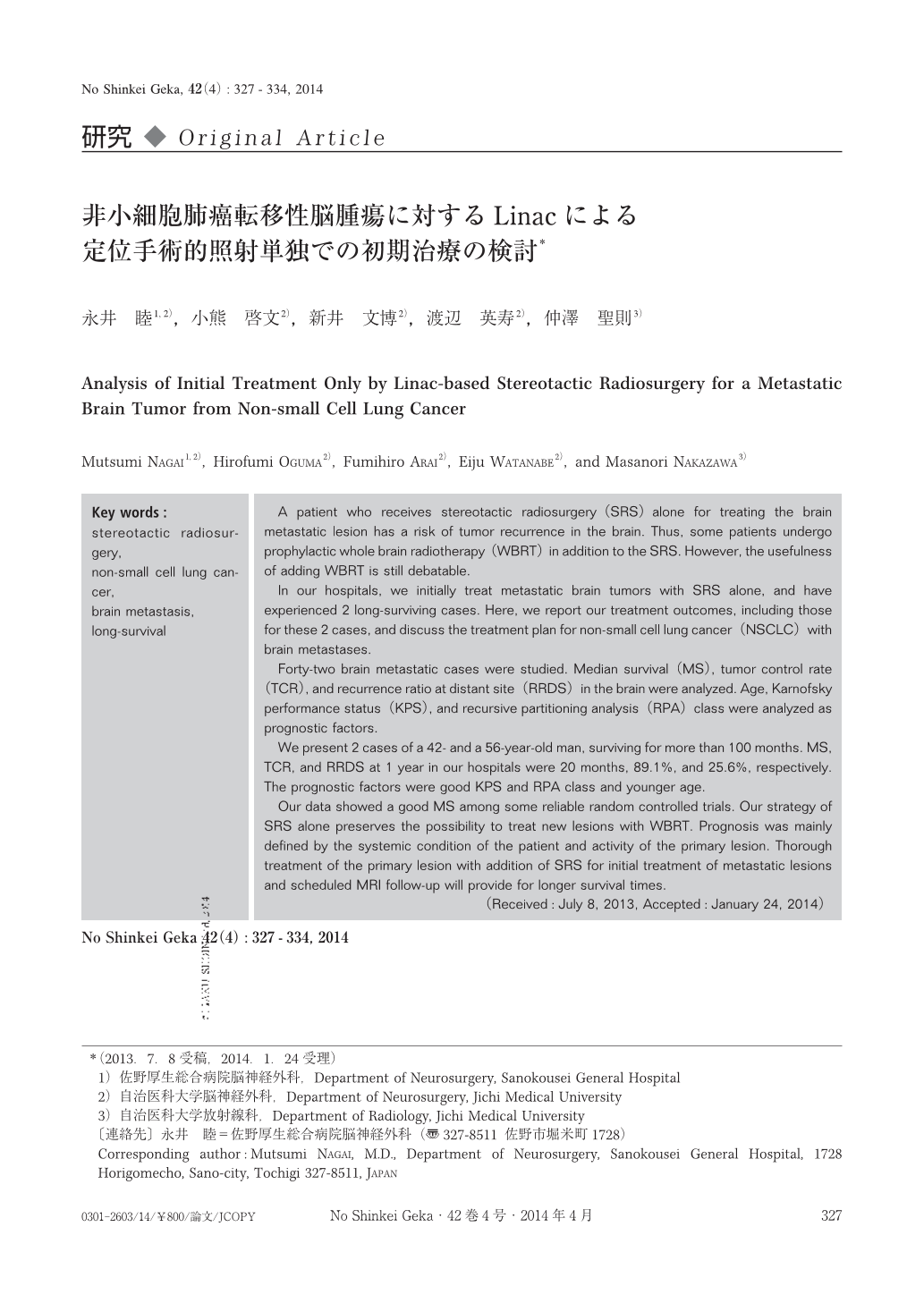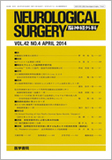Japanese
English
- 有料閲覧
- Abstract 文献概要
- 1ページ目 Look Inside
- 参考文献 Reference
Ⅰ.はじめに
癌の脳転移は,癌原発死因の50%を占める憂慮すべき病態である14).転移性脳腫瘍の原発巣では肺癌によるものが最多で,肺癌自体が本邦の癌死亡率の1位を占める最重要疾患である.脳転移を来した非小細胞肺癌(non-small cell lung cancer:NSCLC)の進行度は遠隔転移があることでstage 4となり,原発巣の浸潤具合やリンパ節転移の有無にかかわらず最も進行した癌の範疇に入り,その生命予後は最も短い.NSCLCの脳転移巣に対する治療方針についてはさまざまなrandomized control trials(RCT)がある.手術適応がある場合に手術摘出+全脳照射(whole-brain radiotherapy:WBRT)を行うことが有効であることが示された14,23)とはいえ,2年生存率は11%で生存期間中央値は7.9カ月と未だ良好とはいえない17).手術適応がない場合はさらに不良でWBRTのみでの生存期間中央値は3~4カ月である12,15).
しかし1990年頃より転移性脳腫瘍に対して定位手術的照射(stereotactic radiosurgery:SRS)が行われはじめた.SRSは病巣の大きさと個数に施行適応の制限があるものの,転移性脳腫瘍に対して手術摘出+WBRTに匹敵する腫瘍局所制御率13)とoverall survival(OS)を示し11,16),さらに入院期間の短縮が得られるためquality of lifeを考慮しなければならないstage 4の治療方法としてふさわしいと考えられる.2008年に発表された放射線治療計画ガイドラインによると,NSCLCの脳転移への治療法としてSRS単独による初期治療法は,それにWBRTを加えた群と比較して頭蓋内再発率が高くなるという発表2)に鑑み,「転移の個数にかかわらずWBRTによる放射線治療を標準治療とし,SRS単独療法はオプションとして考慮されるもの」という捉え方で記述された.しかし薬物治療の進歩により長期生存するstage 4の症例が増えるのに伴い,2009年に発表されたWBRT追加による認知機能障害の可能性3)を回避するためにSRS単独での初期治療を行う施設が多くなってきた.実際,2012年に改訂された放射線治療計画ガイドラインでは,SRS単独とSRS+WBRTの比較においてOSに差はなかったという2つのランダム化試験の結果を踏まえ3,8)「SRSが適応される症例では初回治療でのWBRTを避け,SRS単独とMRIによる頻回の経過観察を行うという選択肢もある」と,初期治療としてのSRS単独療法が評価された形で記載内容が変更された.現在では多くの施設においてSRSの適応のある脳転移症例に対してはSRS単独で初期治療を行っている.
われわれの施設でも2001年より,適応のある症例にはSRS単独での初期治療を行っているが,症例が蓄積され,8年以上にわたる長期生存2症例を経験するに至った.ここで当施設にて蓄積されたデータを解析し,現在も無再発状態を維持しているこれら2症例の報告とともに示す.これらの結果はNSCLC脳転移患者に対するSRS単独での初期治療の是非に対するevidenceとなり得ると考えられる.
A patient who receives stereotactic radiosurgery(SRS)alone for treating the brain metastatic lesion has a risk of tumor recurrence in the brain. Thus, some patients undergo prophylactic whole brain radiotherapy(WBRT)in addition to the SRS. However, the usefulness of adding WBRT is still debatable.
In our hospitals, we initially treat metastatic brain tumors with SRS alone, and have experienced 2 long-surviving cases. Here, we report our treatment outcomes, including those for these 2 cases, and discuss the treatment plan for non-small cell lung cancer(NSCLC)with brain metastases.
Forty-two brain metastatic cases were studied. Median survival(MS), tumor control rate(TCR), and recurrence ratio at distant site(RRDS)in the brain were analyzed. Age, Karnofsky performance status(KPS), and recursive partitioning analysis(RPA)class were analyzed as prognostic factors.
We present 2 cases of a 42- and a 56-year-old man, surviving for more than 100 months. MS, TCR, and RRDS at 1 year in our hospitals were 20 months, 89.1%, and 25.6%, respectively. The prognostic factors were good KPS and RPA class and younger age.
Our data showed a good MS among some reliable random controlled trials. Our strategy of SRS alone preserves the possibility to treat new lesions with WBRT. Prognosis was mainly defined by the systemic condition of the patient and activity of the primary lesion. Thorough treatment of the primary lesion with addition of SRS for initial treatment of metastatic lesions and scheduled MRI follow-up will provide for longer survival times.

Copyright © 2014, Igaku-Shoin Ltd. All rights reserved.


